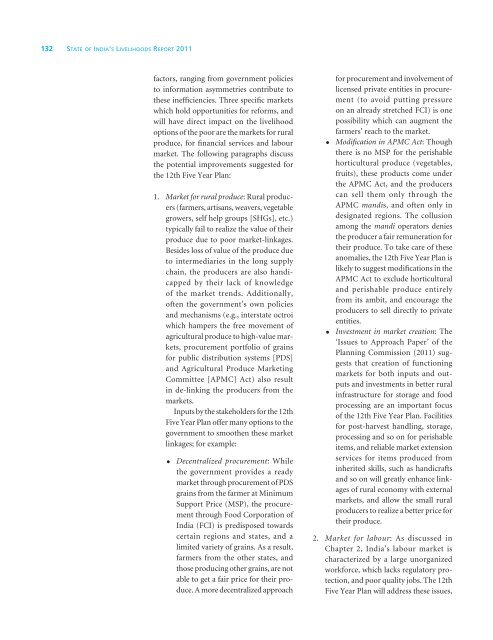SOIL Report 2011 - ACCESS Development Services
SOIL Report 2011 - ACCESS Development Services
SOIL Report 2011 - ACCESS Development Services
- No tags were found...
Create successful ePaper yourself
Turn your PDF publications into a flip-book with our unique Google optimized e-Paper software.
132 State of India’s Livelihoods <strong>Report</strong> <strong>2011</strong>factors, ranging from government policiesto information asymmetries contribute tothese inefficiencies. Three specific marketswhich hold opportunities for reforms, andwill have direct impact on the livelihoodoptions of the poor are the markets for ruralproduce, for financial services and labourmarket. The following paragraphs discussthe potential improvements suggested forthe 12th Five Year Plan:1. Market for rural produce: Rural producers(farmers, artisans, weavers, vegetablegrowers, self help groups [SHGs], etc.)typically fail to realize the value of theirproduce due to poor market-linkages.Besides loss of value of the produce dueto intermediaries in the long supplychain, the producers are also handicappedby their lack of knowledgeof the market trends. Additionally,often the government’s own policiesand mechanisms (e.g., interstate octroiwhich hampers the free movement ofagricultural produce to high-value markets,procurement portfolio of grainsfor public distribution systems [PDS]and Agricultural Produce MarketingCommittee [APMC] Act) also resultin de-linking the producers from themarkets.Inputs by the stakeholders for the 12thFive Year Plan offer many options to thegovernment to smoothen these marketlinkages; for example:• Decentralized procurement: Whilethe government provides a readymarket through procurement of PDSgrains from the farmer at MinimumSupport Price (MSP), the procurementthrough Food Corporation ofIndia (FCI) is predisposed towardscertain regions and states, and alimited variety of grains. As a result,farmers from the other states, andthose producing other grains, are notable to get a fair price for their produce.A more decentralized approachfor procurement and involvement oflicensed private entities in procurement(to avoid putting pressureon an already stretched FCI) is onepossibility which can augment thefarmers’ reach to the market.• Modification in APMC Act: Thoughthere is no MSP for the perishablehorticultural produce (vegetables,fruits), these products come underthe APMC Act, and the producerscan sell them only through theAPMC mandis, and often only indesignated regions. The collusionamong the mandi operators deniesthe producer a fair remuneration fortheir produce. To take care of theseanomalies, the 12th Five Year Plan islikely to suggest modifications in theAPMC Act to exclude horticulturaland perishable produce entirelyfrom its ambit, and encourage theproducers to sell directly to privateentities.• Investment in market creation: The‘Issues to Approach Paper’ of thePlanning Commission (<strong>2011</strong>) suggeststhat creation of functioningmarkets for both inputs and outputsand investments in better ruralinfrastructure for storage and foodprocessing are an important focusof the 12th Five Year Plan. Facilitiesfor post-harvest handling, storage,processing and so on for perishableitems, and reliable market extensionservices for items produced frominherited skills, such as handicraftsand so on will greatly enhance linkagesof rural economy with externalmarkets, and allow the small ruralproducers to realize a better price fortheir produce.2. Market for labour: As discussed inChapter 2, India’s labour market ischaracterized by a large unorganizedworkforce, which lacks regulatory protection,and poor quality jobs. The 12thFive Year Plan will address these issues,














